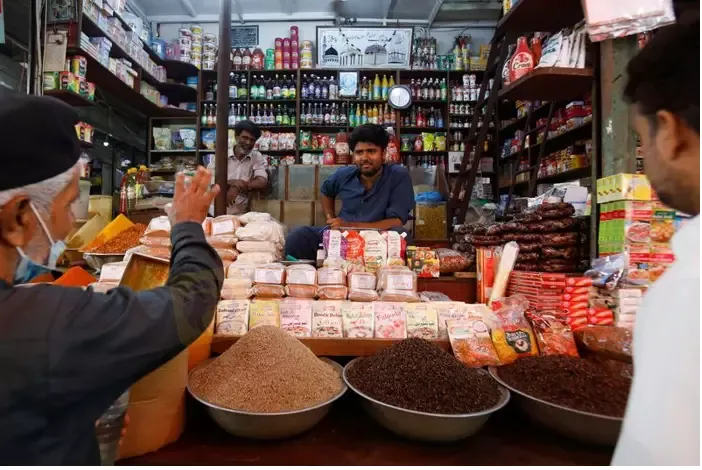简体中文
繁體中文
English
Pусский
日本語
ภาษาไทย
Tiếng Việt
Bahasa Indonesia
Español
हिन्दी
Filippiiniläinen
Français
Deutsch
Português
Türkçe
한국어
العربية
Pakistan’s annual inflation rises to 14-year high at 24.9% in July
Abstract:Pakistan’s annual consumer price inflation reached 24.9% in July, up from 21.3% in June and the highest in 14 years, the statistics bureau said on Monday.

Non-food items, mainly fuel and electricity charges, were the major reason for the rise, it said, adding surging prices for vegetables, pulses, cooking oil, wheat flour and milk were also a significant factor.
On a month-on-month basis, inflation jumped by 4.3% in July, the bureau said.
Pakistan is in economic turmoil with fast depleting foreign reserves, an historic depreciation of the rupee against U.S. dollar, and soaring inflation.
However, sufficient measures have been put in place to contain the current account deficit as energy imports have declined and non-energy imports showed moderate falls, the central bank and finance ministry said in a joint statement.
It was issued on Sunday night, hours after the ministry announced that the countrys imports had fallen one third in the month of July.
The significant cut in imports – both in oil and non-oil payments – will remove pressure on the rupee, which had depreciated over 25% this year against the U.S. dollar, Finance Minister Miftah Ismail said on Sunday.
The rupee slightly recovered on Monday with a 53 paisa appreciation.
“Macroeconomic policies – both fiscal policy and monetary policy – have been appropriately tightened to reduce demand-led pressures and rein in the current account deficit,” the joint statement said.
It added that the government was ready to implement all conditions agreed with International Monetary Fund to be able to receive its next tranche if approved by its board, which is likely to meet later this month.
The IMF reached a staff-level agreement with Pakistan last month for the disbursement of a $1.2 billion tranche, which will unlock other external financing avenues.

Disclaimer:
The views in this article only represent the author's personal views, and do not constitute investment advice on this platform. This platform does not guarantee the accuracy, completeness and timeliness of the information in the article, and will not be liable for any loss caused by the use of or reliance on the information in the article.
Read more

How to Use Retracement in Trading
Understanding retracement is essential for strategic trading. In today’s article, we will focus on the retracement is a temporary, short-lived pullback in the price of a financial instrument, like a stock or an index, that occurs within a larger, established trend. Think of it as a brief pause or a correction before the market continues its original movement. Unlike a trend reversal, which signals a fundamental shift in direction, a retracement represents a temporary deviation that doesn't jeopardize the long-term trend.

What Is Indices in Forex? A Beginner’s Guide to Trading Forex Indices
Understand what indices in forex are, how DXY works, key differences vs pairs, pros/cons, and where to trade CFDs—beginner-friendly, expert-backed guide.

Malaysian Finfluencers Could Face RM10 Million Fine or 10 Years in Prison!
A new regulatory measure by the Securities Commission Malaysia (SC) is set to change the country’s online trading and financial influencer landscape. Starting 1 November 2025, any trader or influencer caught promoting an unlicensed broker could face a fine of up to RM10 million, a prison sentence of up to 10 years, or both.

Juno Markets: A Closer Look at Its Licenses
When selecting a broker, understanding its regulatory standing is an important part of assessing overall reliability. For traders seeking to protect their capital, ensuring that a platform operates under recognised and stringent oversight can make all the difference. Keep reading to learn more about Juno Markets and its licenses.
WikiFX Broker
Latest News
What Is Indices in Forex? A Beginner’s Guide to Trading Forex Indices
FBI Issues Urgent Warning on Crypto Recovery Scams
Robinhood Moves Toward MENA Expansion with Dubai DFSA License Application
How to Use Retracement in Trading
CySEC warns the public against 17 investment websites
Fake Trader Faces 20 Years & RM9 Million Fine for RM1.45 Mil Derivatives Scam
Complaints Against Weltrade | Traders Can’t Get Their Money Back
WikiFX Community Event Series, “Thailand Elites’ View”
Juno Markets: A Closer Look at Its Licenses
Germany's Industrial Core Is Collapsing Under The US Trade Deal And The Green Agenda
Currency Calculator


